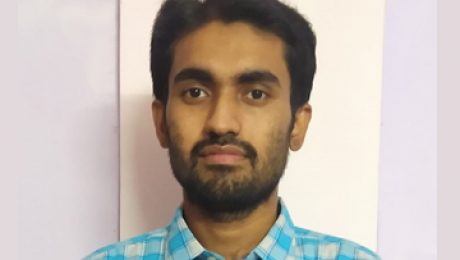Dr Koyel Chakravarty
- Published in Faculty, Mathematics Faculty, SEAS
100% Erasmus Mundus Scholarship and MS opportunities in Europe
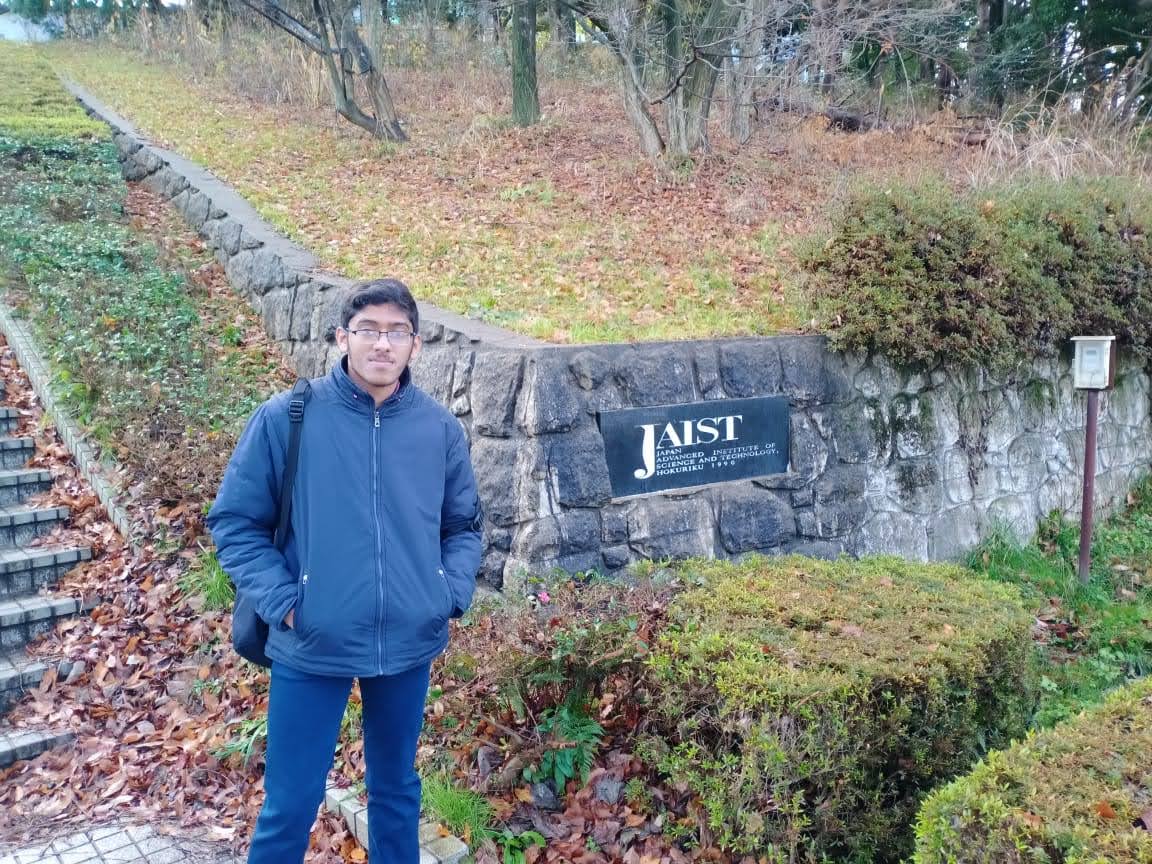 SRM University-AP has numerous success stories and student accomplishments to share with the world. What makes the story of Bennet Benny different is the magnitude of his winning and the miles he has crossed after setting foot to achieve his dreams. He has secured the much-coveted Erasmus Mundus Joint Masters Scholarship with a whopping sum of € 33,600 for two years. With the 100% EMJM scholarship, he can now pursue QuanTEEM Master’s across four different universities, each semester in one of these universities:
SRM University-AP has numerous success stories and student accomplishments to share with the world. What makes the story of Bennet Benny different is the magnitude of his winning and the miles he has crossed after setting foot to achieve his dreams. He has secured the much-coveted Erasmus Mundus Joint Masters Scholarship with a whopping sum of € 33,600 for two years. With the 100% EMJM scholarship, he can now pursue QuanTEEM Master’s across four different universities, each semester in one of these universities:
University Bourgogne Franche-Comté (France)
Technische Universität Kaiserslautern (Germany)
Aarhus University (Denmark)
Moskovskiy Fiziko-Tekhnicheskiy Institut (Russia)
Internship at JAIST, Japan -2019
Like every other student, Bennet joined the Bachelor’s degree programme at the Department of Physics in 2018 with an irrepressible desire to dive into the depths of Physics. His undying passion for grasping the subject’s nuances is an influential lesson for all students to emulate. When he was in the second year of his graduate studies, Bennet won the Sakura Science Internship under the supervision of Prof. Ryo Maezono at JAIST, Japan. The internship was funded by the Japan Science and Technology Agency (JST), a government funding agency. For him, this was an excellent opportunity to learn more deeply about quantum mechanics. It also helped him raise his awareness of computational physics, its advantages, uses and the latest research around it.
“I was able to interact with many international scholars and researchers at the Japan Advanced Institute of Science and Technology. It helped me learn about the various ways through which I could fund my higher education. Therefore, after returning to SRM University-AP, I could work in the necessary direction to build my profile accordingly.” Bennet remarked. The enormous lessons he learned there helped him publish a research paper under the guidance of Prof Ranjit Thapa and his PhD students in the Computational Physics laboratory. “The Department of Physics has always motivated me to reach greater heights”, he added.
NTU-India Connect Research Programme 2022
Bennet has also proved his mettle by securing yet another internship opportunity as part of the NTU-India Connect Research Programme 2022. He was selected to spend a semester (Spring term) at NTU, Singapore with a full fellowship during the final year of graduation. As a young researcher, he has gained immense exposure and experience in such a short period giving him a competitive edge to move further in the direction of his dreams. “It has always been my dream to pursue a research career in Physics”, he asserted.
Looking Forward to QuanTEEM Master’s
The QuanTEEM Master’s programme is based on Quantum technologies and provides an excellent opportunity to build a research network in multiple countries in the European Union. He aspires to gain a deeper understanding of quantum mechanics and wishes to use the knowledge to improve our civilisation. In the words of Bennet, “We should never let the fear of failure deter us from trying. I feel that to reach our best potential; we need to face the challenges in life rather than be disheartened by them. Hence, I would encourage my fellow students never to hesitate to seek new opportunities.”
- Published in Academics, Blog, Departmental News, News, Physics News, Research, Sciences
Reverse carry select adder and graphene-based field-effect transistor
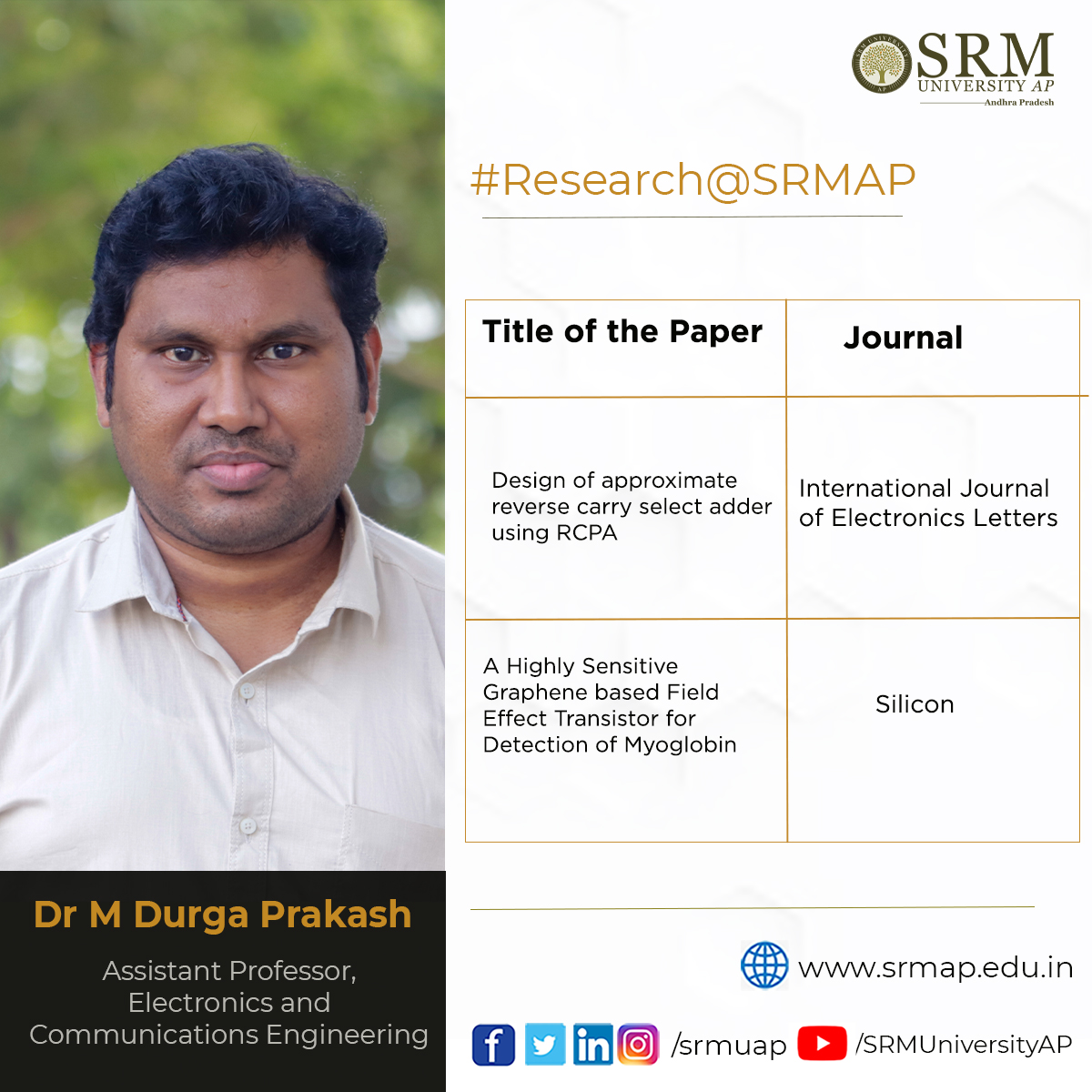 By publishing two papers in well-acclaimed research journals, Assistant Professor Dr M Durga Prakash of the Department of Electronics and Communication Engineering is expanding the possibilities of his research domain through innovative ideas. The first paper was published in the International Journal of Electronics Letters, an internationally renowned peer-reviewed rapid communication journal. It is titled Design of approximate reverse carry select adder using RCPA and has an impact factor of 1.5.
By publishing two papers in well-acclaimed research journals, Assistant Professor Dr M Durga Prakash of the Department of Electronics and Communication Engineering is expanding the possibilities of his research domain through innovative ideas. The first paper was published in the International Journal of Electronics Letters, an internationally renowned peer-reviewed rapid communication journal. It is titled Design of approximate reverse carry select adder using RCPA and has an impact factor of 1.5.
Abstract
An approximate carry select adder (CSLA) with reverse carry propagation (RCSLA) is shown in this work. This RCSLA was designed with a reverse carry propagate full adder (RCPFA). In the RCPFA structure, the carry signal propagates in the reverse direction, that is, from MSB part to LSB part, then the carry input has greater importance compared to the output carry. Three types of implementations were designed in RCPFA based on the design parameters. This method was applied to RCA & CSLA to design other types of approximate adders. These designs and simulations were done in CADENCE Software tool with 45 nm COMS technology. The design parameters of the three CSLA implementations with RCPFA are compared with the existing CSLA adders.
The other paper, A highly sensitive graphene-based field-effect transistor for detection of myoglobin, has been published in the Silicon Journal, an international and interdisciplinary journal, with an impact factor of 2.67.
Abstract
Biomedical applications adapt Nanotechnology-based transistors as a key component in the biosensors for diagnosing life-threatening diseases like Covid-19, Acute Myocardial Infarction (AMI), etc. The proposed work introduces a new biosensor, based on the Graphene Field Effect Transistor (GFET), which is used in the diagnosis of Myoglobin (Mb) in human blood. Graphene-based biosensors are faster, more precise, stronger, and more trustworthy. A GFET is created in this study for the detection of myoglobin biomarker at various low concentrations. Because graphene is sensitive to a variety of biomarker materials, it can be employed as a gate material. When constructed Graphene FET is applied to myoglobin antigens, it has a significant response. The detection level for myoglobin is roughly 30 fg/ml, which is quite high. The electrical behaviour of the GFET-based biosensor in detecting myoglobin marker is ideal for Lab-on-Chip platforms and Cardiac Point-of-Care Diagnosis.
- Published in Departmental News, ECE NEWS, News, Research News
Towards deep learning algorithms for space exploration
Rohan Reddy Sambidi received admission offers with scholarships upto $16,500
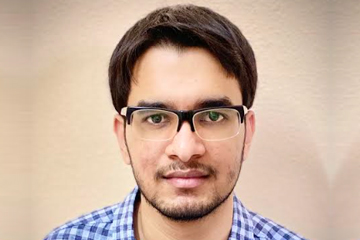 Rohan Reddy Sambidi from Btech CSE at SRM University-AP is delighted to have received admission offers from numerous universities abroad. He secured admission to MS in Computer Science at Purdue University, Fort Wayne; Texas A&M University, College Station (Distance); Arizona State University, Tempe; Illinois Institute of Technology, Chicago; University of South Florida, Tampa; and the University of Houston. Along with this, he received an offer from the University of Maryland, College Park for the Master of Professional Studies in Machine Learning programme. Admission offers came with a scholarship of $10,000 from ASU and $16,500 from IIT Chicago.
Rohan Reddy Sambidi from Btech CSE at SRM University-AP is delighted to have received admission offers from numerous universities abroad. He secured admission to MS in Computer Science at Purdue University, Fort Wayne; Texas A&M University, College Station (Distance); Arizona State University, Tempe; Illinois Institute of Technology, Chicago; University of South Florida, Tampa; and the University of Houston. Along with this, he received an offer from the University of Maryland, College Park for the Master of Professional Studies in Machine Learning programme. Admission offers came with a scholarship of $10,000 from ASU and $16,500 from IIT Chicago.
The suitable choice
Rohan has decided to join the MS in Computer Science programme at Arizona State University. He plans to prepare a thesis and focus his research on the field of machine learning. He wants to explore and address the challenges of designing efficient deep learning algorithms for space exploration through telescopic imagery. He is also interested in doing a few courses on theoretical computer science.
Finding the best
For selecting universities, Rohan started by acquiring a list of reputed universities from the QS Rankings website. Then he shortlisted universities by focusing on the course curriculum, faculty, and resources for student research. He has completed his bachelor’s degree at SRM university-AP with a major in Computer Science and Engineering and a minor in Physics.
Support from SRM AP
The mentorship of accomplished faculty has helped Rohan build strong foundational knowledge in his discipline. Through the course projects, UROP, and the Capstone Project, he has developed research skills and built a compelling profile essential for admission to leading universities in the USA. He expressed his gratitude to his professors and mentors, Prof Dr Ragunathan T, Dr Jatindra Kumar Dash, and Dr Murali Krishna Enduri, for their relentless guidance. He is immensely grateful for the opportunities that he received from SRM university-AP.
- Published in CSE NEWS, Departmental News, News, Students Achievements
Yesterday you said tomorrow!
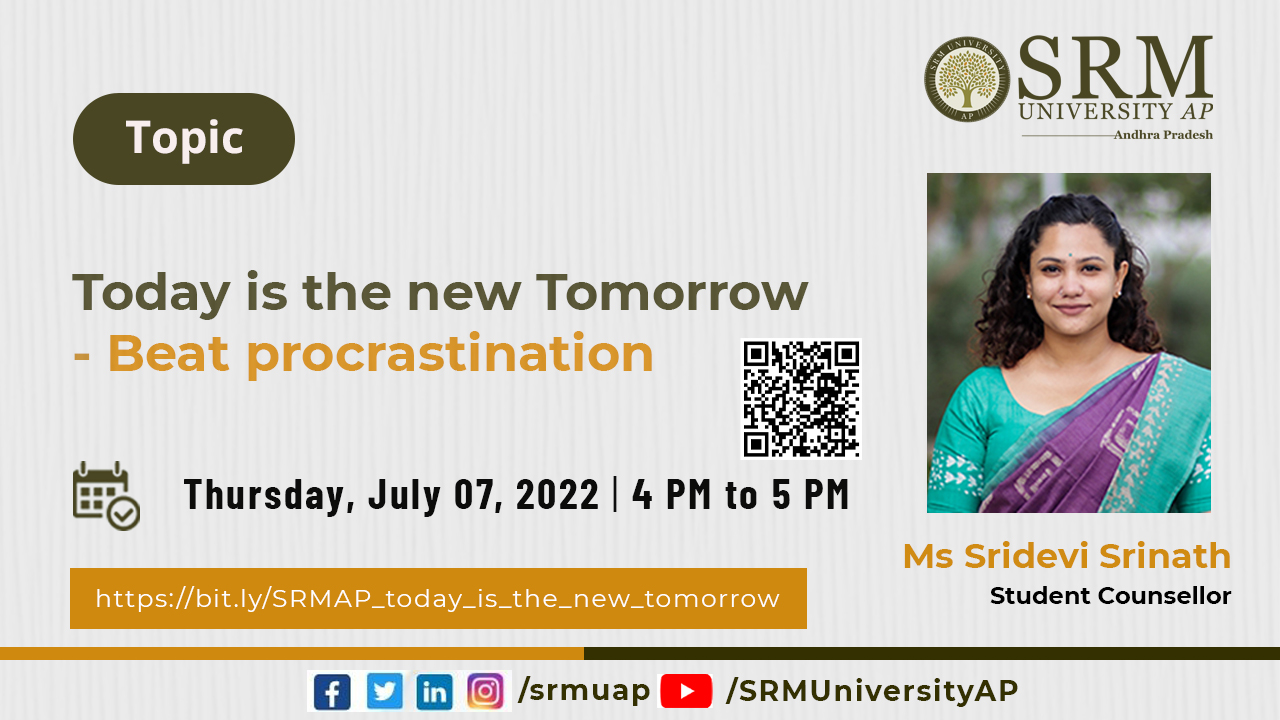 Procrastination is irrational and existential at its core. The ambiguous nature of self-awareness makes us feel rotten and glad at the same time while putting things off for a moment. It is a coping mechanism to resist the challenging emotions caused by the sight of certain tasks. That’s why procrastination is never an issue of time management but emotion regulation. It becomes a habit and not a once-in-a-blue-moon phenomenon.
Procrastination is irrational and existential at its core. The ambiguous nature of self-awareness makes us feel rotten and glad at the same time while putting things off for a moment. It is a coping mechanism to resist the challenging emotions caused by the sight of certain tasks. That’s why procrastination is never an issue of time management but emotion regulation. It becomes a habit and not a once-in-a-blue-moon phenomenon.
The Department of Student Affairs is coming up with a talk on Today is the new Tomorrow – Beat procrastination, which will be handled by Student Counsellor Ms Sridevi Srinath. It’s time to break the ties between procrastination and productivity. It has nothing to do with the effectiveness of productive effort but with managing emotions. This session will help you break the procrastination cycle and develop an action plan that works for you.
Date: July 07, 2022
Time: 4 pm to 5 pm
About the speaker
Ms Sridevi Srinath has been in the field of counselling for over eight years. She holds an MSc in Counselling Psychology from Madras School of Social Work and an MPhil in Psychology from the University of Madras. Working in a school previously, she has over five years of experience in impacting the lives of children and adults across issues such as anxiety, stress, behavioural changes, soft and life skills, and career guidance, to name a few. She also has certification from UCLA Extension in Career Guidance and Counselling.
Come, and join the session!
Let tomorrow be a fallacy; start getting your stuff done today
- Published in Events, Students Affairs Events
SRM AP to take part in Akhil Bharatiya Shiksha Samagam
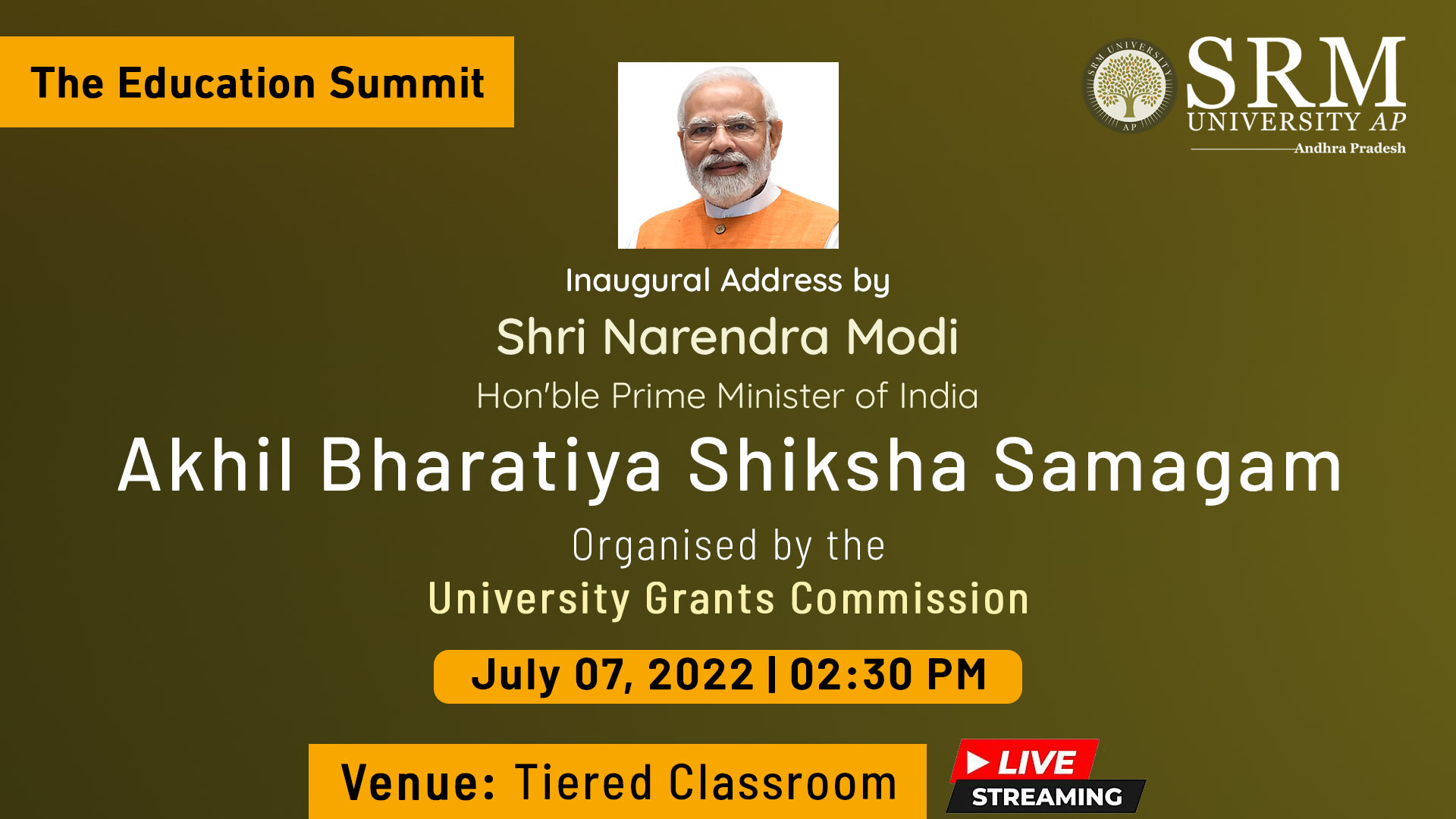 The higher education regulatory body, University Grants Commission (UGC) is organising a three-day education summit, Akhil Bharatiya Shiksha Samagam , at Varanasi, Uttar Pradesh, from July 7 to July 9, 2022. The Hon’ble Prime Minister of India, Shri Narendra Modi will grace the occasion by delivering the inaugural address. SRM university-AP is being part of the summit by live-streaming the inaugural event on campus.
The higher education regulatory body, University Grants Commission (UGC) is organising a three-day education summit, Akhil Bharatiya Shiksha Samagam , at Varanasi, Uttar Pradesh, from July 7 to July 9, 2022. The Hon’ble Prime Minister of India, Shri Narendra Modi will grace the occasion by delivering the inaugural address. SRM university-AP is being part of the summit by live-streaming the inaugural event on campus.
Academicians, researchers, policymakers, professional and educational experts, and industry experts from all over the country will gather at the summit to discuss the diverse perspectives of the National Education Policy 2020 and its role in transforming higher education. The workshop intends to analyse the impact of the education policy after the successful implementation of several initiatives in the past two years. The summit will involve thought-provoking conversations on articulating action plans, implementation strategies, multidisciplinary and holistic education, skill development and employability, Indian knowledge systems, etc. It will also consider the challenges being faced by educational institutes and articulate solutions.
Date: July 07, 2022
Time: 2.30 pm
Venue: Tiered classroom Level- V, Admin Block
Join the live telecast of the inaugural address!
- Published in Events
Find your place behind the screen
No form of art goes beyond ordinary consciousness as film does, straight to our emotions, deep into the twilight room of the soul
– Ingmar Bergman
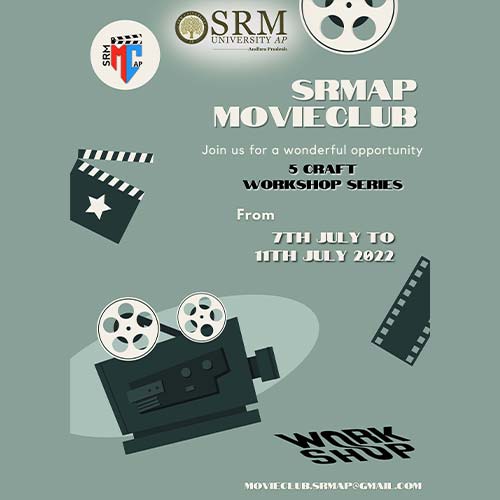 Inside the dark space of a movie theatre, it’s just us, the screen, and the projecting light against the world. We join the revolt of the artist against the real. The very idea of perceiving the comfort and discomfort of a cinema while sitting with a bunch of unfamiliar faces is enough to make you fall into the rabbit hole of filmmaking.
Inside the dark space of a movie theatre, it’s just us, the screen, and the projecting light against the world. We join the revolt of the artist against the real. The very idea of perceiving the comfort and discomfort of a cinema while sitting with a bunch of unfamiliar faces is enough to make you fall into the rabbit hole of filmmaking.
Ever wondered how people connect with people through mere moving images? Ever think of the stories you want to tell but cannot fix frames and pour life into them? It is the filmmaking enthusiast in you who makes you think of what is in a frame and what is out.
The fascinating thing about cinema is that it is an endless tool made up of pretty much the same elements. Cinema uses the language of dreams and each of them is entirely different from the other. The Movie Club is ready with a filmmaking workshop to awaken the storyteller in you. The workshop offers an intensive and instructional five-day programme focusing on the five main agents of cinema, including Scriptwriting, Direction, Photography, Editing, and Acting.
Date: From July 7 to July 11, 2022
Time: 6 PM
With every good film you see, you feel reborn
Join the workshop and find your place behind the screen!
- Published in Events, Students Affairs Events
Published the 5th consecutive article in the American Chemical Society
The Department of chemistry has always been a dynamic space for innovative and inspiring research. Recently, Assistant Professor Dr Nimai Mishra published his fifteenth research paper from SRM university-AP as a corresponding author. The paper is titled Post-synthesis Treatment with Lead Bromide for Obtaining Near Unity Photoluminescence Quantum Yield and Ultra-Stable Amine Free CsPbBr 3 Perovskite Nanocrystal and is published in the Q1 journal, The Journal of Physical Chemistry C with an impact factor of 4.2. The research group is comprised of Dr Mishra’s PhD students Mr Syed Akhil, Dr V G Vasavi Dutt, and Mr Rahul Singh. This is the group’s fifth consecutive article published in the American Chemical Society.
About the article
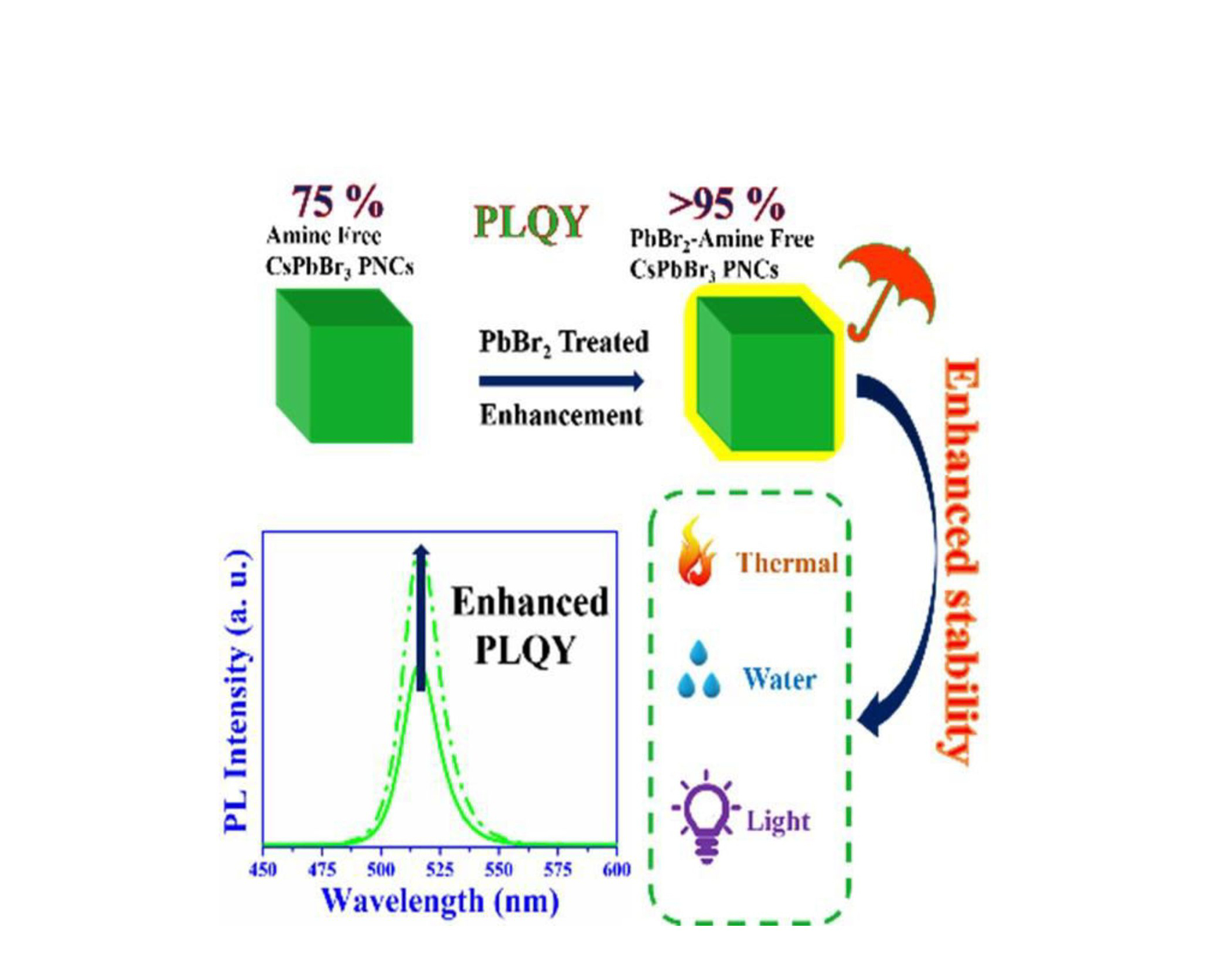 The article reports Ultra-Stable and Near Unity Photoluminescence Quantum Yield Amine Free CsPbBr 3 Perovskite Nanocrystal Post-synthesis Treatment with Lead Bromide. Herein, the researchers have introduced a simple lead bromide (PbBr 2 ) post-treatment process to achieve the near-unity PLQY (>95 %) in amine-free CsPbBr 3 PNCs. Furthermore, PbBr 2 treatment enables these materials to drastically improve stability in different environmental conditions (polar solvents, light, and heat). In addition, a green-emitting down- converted light-emitting diode was fabricated using PbBr 2 treated amine-free CsPbBr 3 PNCs, which shows its considerable prospects for display applications. Thus, the results of the research will promote these PbBr 2 treated amine-free inorganic perovskite nanocrystals for commercial development in optoelectronic applications.
The article reports Ultra-Stable and Near Unity Photoluminescence Quantum Yield Amine Free CsPbBr 3 Perovskite Nanocrystal Post-synthesis Treatment with Lead Bromide. Herein, the researchers have introduced a simple lead bromide (PbBr 2 ) post-treatment process to achieve the near-unity PLQY (>95 %) in amine-free CsPbBr 3 PNCs. Furthermore, PbBr 2 treatment enables these materials to drastically improve stability in different environmental conditions (polar solvents, light, and heat). In addition, a green-emitting down- converted light-emitting diode was fabricated using PbBr 2 treated amine-free CsPbBr 3 PNCs, which shows its considerable prospects for display applications. Thus, the results of the research will promote these PbBr 2 treated amine-free inorganic perovskite nanocrystals for commercial development in optoelectronic applications.
Explanation of the research
Cesium lead halide perovskite nanocrystals (PNCs) have been the flourishing area of research in the field of photovoltaic and optoelectronic applications because of their excellent optical and electronic properties. Mainly, cesium lead bromide (CsPbBr 3 ) NCs with bright green photoluminescence (PL) and narrow full-width at half-maximum (FWHM) of < 25 nm is the most desirable for television displays and green-emitting LEDs. Improving the photoluminescence quantum yields (PLQYs) and optimizing the stability have been challenging tasks to promote cesium lead halide (CsPbX3; X=Cl, Br and I) perovskite nanocrystals (PNCs) for real optoelectronic applications. In recent years, the amine- free synthesis route has become an option for making stable CsPbX 3 PNCs.
- Published in Chemistry-news, Departmental News, News, Research News
US delegates to visit SRM university-AP
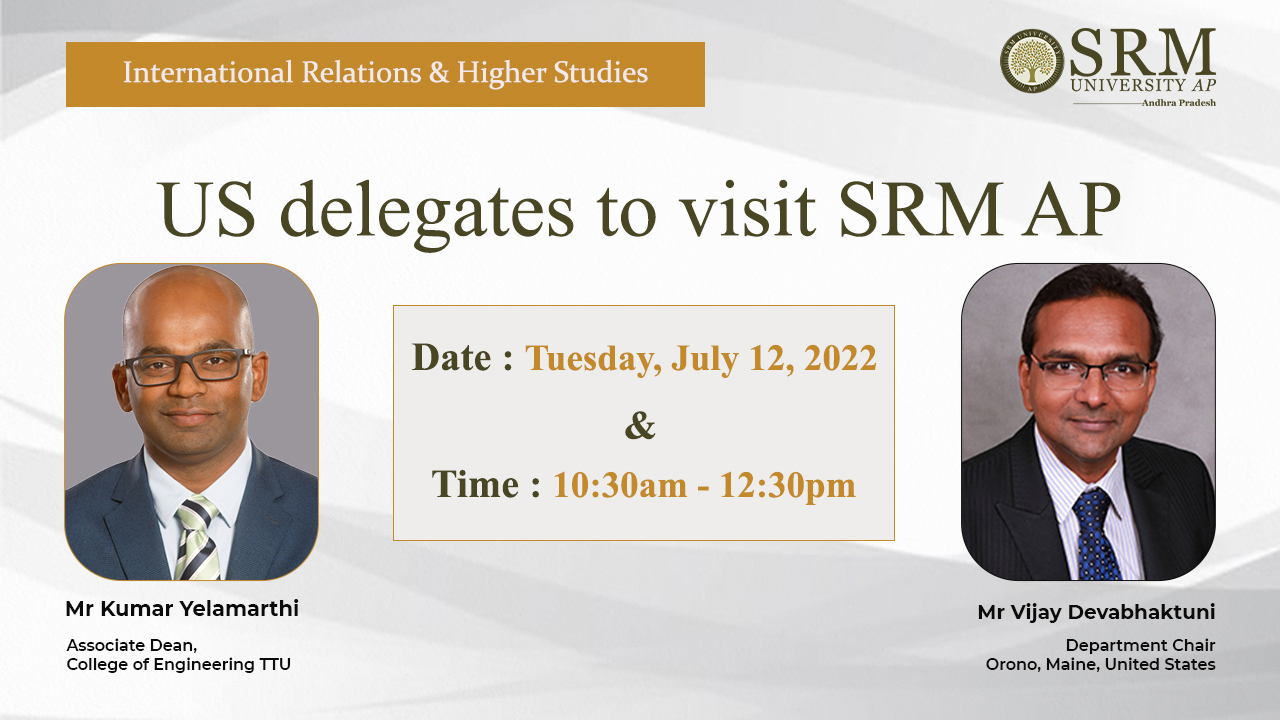 International collaborations have always played a significant part in locating the majesty of SRM university-AP in the education sector. The Office of International Relations and Higher Studies is hosting the US delegate visit on July 12, 2022, from 10.30 am to 12.30 pm. The visit intends a productive interaction between the visiting delegates and the institution’s faculty. Mr Kumar Yelamarthi and Mr Vijay Devabhaktuni are dignified guests who will grace the occasion with their valuable presence. The interaction will be happing in the Board room of the university and will offer the students an opportunity to interconnect with the delegates.
International collaborations have always played a significant part in locating the majesty of SRM university-AP in the education sector. The Office of International Relations and Higher Studies is hosting the US delegate visit on July 12, 2022, from 10.30 am to 12.30 pm. The visit intends a productive interaction between the visiting delegates and the institution’s faculty. Mr Kumar Yelamarthi and Mr Vijay Devabhaktuni are dignified guests who will grace the occasion with their valuable presence. The interaction will be happing in the Board room of the university and will offer the students an opportunity to interconnect with the delegates.
About the delegates
Mr Kumar Yelamarthi is the Associate Dean and Professor at the College of Engineering at TTU. He has over 15 years of research experience in embedded system, mobile robotics, and integrated circuit design. He also has more than ten years of experience in the areas of nanoscale integrated circuit design, CAD tool development, design automation, etc. More than 150 articles of his have been published in peer-reviewed journals and conference proceedings. He taught a diverse range of classes from freshman through graduate PhD levels on various topics. He has introduced several new classes into the undergraduate curriculum for computer or electrical engineering technology majors.
Mr Vijay Devabhaktuni received his PhD from Carleton University, Canada, with a senate medal. Between 2005 and 2008, he held the prestigious Canada Research Chair at Concordia University, Canada. After serving the University of Toledo between 2008 and 2018 in academic and research leadership roles, he served Purdue University Northwest as ECE Chair between 2018 and 2021. Currently, he is the Department Chair and Norman Stetson Professor of ECE at the University of Maine. His vision is to transform traditional course-based learning into experiential-based and soft skill-based learning for GenZ students.
- Published in Events, International Relations, IR-Events
Know your skills, know your worth!
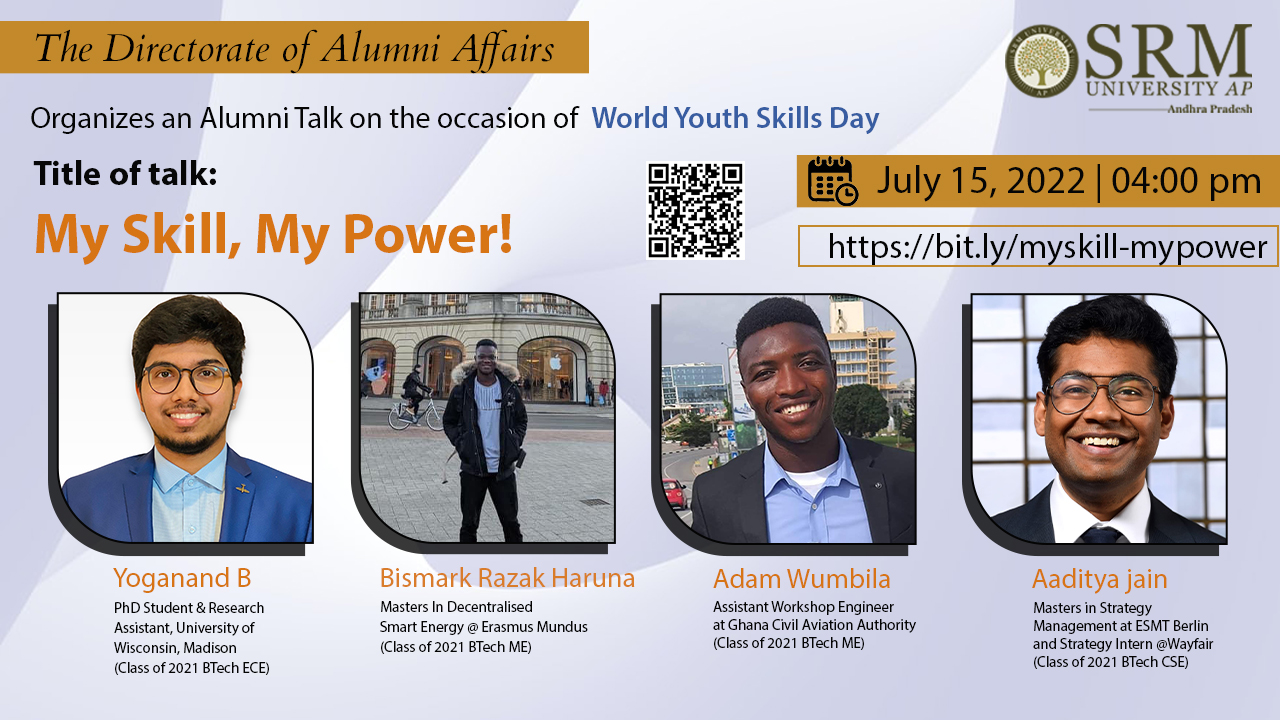 Between 1997 and 2017, the young population increased by 139 million, and the population of the young labour force declined to 58.7 million. Worldwide, one out of five people is not in employment, education, and training. Among these, the number of women is considerably huge. This is where World Youth Skills Day comes into the spotlight. The Directorate of Alumni Affairs is organising an Alumni Talk on My Skill, My Power to discuss the pertinence of competitive skills so as to meet the standards of the constantly advancing job market.
Between 1997 and 2017, the young population increased by 139 million, and the population of the young labour force declined to 58.7 million. Worldwide, one out of five people is not in employment, education, and training. Among these, the number of women is considerably huge. This is where World Youth Skills Day comes into the spotlight. The Directorate of Alumni Affairs is organising an Alumni Talk on My Skill, My Power to discuss the pertinence of competitive skills so as to meet the standards of the constantly advancing job market.
Date: July 15, 2022
Time: 4.00 pm to 5.00 pm
World Youth Skills Day spreads the significance of vocational educational training and developing other skills relevant to local and global economies. The day also highlights skilled youth’s role in addressing current and future global challenges. The Alumni talk features four students from the class of 2021 namely, Yoganand, Bismark Razak Haruna, Aaditya jain, and Adam Wumbila who have already figured out how to channel their fervour for a vibrant tomorrow.
Let’s celebrate the importance of arming the youth with skills for employment, decent work, and entrepreneurship.
Join the webinar! Get to know where your skills can take you to.
- Published in Alumni Relations, Events


